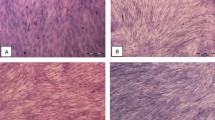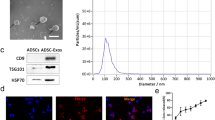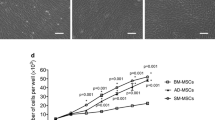Abstract
Tendon and ligament injuries are not uncommon in clinics and have poor self-healing capacity due to their bloodless and slow-proliferative nature. Promoting the repair or reconstruction of an injured structure is an urgent problem. While Scleraxis (Scx) is a highly specific tendon cell marker, its function has not been explored to a large extent. Hence, Recombinant adenovirus was used to study the influence of Scx overexpression on directional differentiation of human amniotic mesenchymal stem cells (hMSCAs). hAMSCs modified with Scx could dramatically enhance the gene expression of tendon-related molecules, containing Scx, collagens I and III, Tenascin-C, fibronectin, matrix metalloproteinase-2 (MMP-2), lysyl oxidase-1 (LOX-1) and Tenomodulin at all-time points (P < 0.05), and the secretion of collagen I and III, fibronectin and Tenascin-C over time (P < 0.05) but did not impact the cell proliferation capacity (P > 0.05). Immunofluorescence staining showed the cobweb-like fusion of collagen I and fibronectin in the AdScx group on day 7, with higher average fluorescence intensity than the control (P < 0.05). After mixing with Matrigel, transplants were subcutaneously implanted in nude mice, obvious inflammation and rejection of immune response were not observed and HE staining showed a histological feature of swirl of fibers is closely linked in parallel in hAMSCs modified with Scx. On the contrary, in the control group, an unorganized connective structure with cell distributed randomly was spotted. The results of promoted directional differentiation of stem cells and the spatial structure of the normal tendon tissue in three-dimensional space manifested that Scx can be used as a specific marker for tendon cells, and as a positive regulator for directional differentiation of hAMSCs, which is possible to be applied to novel therapeutics for clinical tendon and ligament injury by hAMSCs modified with Scx.





Similar content being viewed by others
Data availability
We declared that materials described in the manuscript, including all relevant raw data, will be freely available to any scientist wishing to use them for non-commercial purposes, without breaching participant confidentiality.
Code availability
All data, models, and code generated or used during the study appear in the submitted article.
References
Ajibade DA, Vance DD, Hare JM, Kaplan LD, Lesniak BP (2014) Emerging applications of stem cell and regenerative medicine to sports injuries. Orthop J Sports Med 2:2325967113519935. https://doi.org/10.1177/2325967113519935
Antoniadou E, David AL (2016) Placental stem cells. Best Pract Res Clin Obstet Gynaecol 31:13–29. https://doi.org/10.1016/j.bpobgyn.2015.08.014
Bavin EP, Atkinson F, Barsby T, Guest DJ (2017) Scleraxis is essential for tendon differentiation by equine embryonic stem cells and in equine fetal tenocytes. Stem Cells Dev 26:441–450. https://doi.org/10.1089/scd.2016.0279
Butler DL, Juncosa-Melvin N, Boivin GP, Galloway MT, Shearn JT, Gooch C, Awad H (2008) Functional tissue engineering for tendon repair: a multidisciplinary strategy using mesenchymal stem cells, bioscaffolds, and mechanical stimulation. J Orthop Res 26:1–9. https://doi.org/10.1002/jor.20456
Caliari SR, Harley BA (2014) Structural and biochemical modification of a collagen scaffold to selectively enhance MSC tenogenic, chondrogenic, and osteogenic differentiation. Adv Healthcare Mater 3:1086–1096. https://doi.org/10.1002/adhm.201300646
Chen X, Yin Z, Chen JL, Liu HH, Shen WL, Fang Z, Zhu T, Ji J, Ouyang HW, Zou XH (2014) Scleraxis-overexpressed human embryonic stem cell-derived mesenchymal stem cells for tendon tissue engineering with knitted silk-collagen scaffold. Tissue Eng Part A 20:1583–1592. https://doi.org/10.1089/ten.TEA.2012.0656
Chen T, Zhang P, Chen J, Hua Y, Chen S (2017) Long-term outcomes of anterior cruciate ligament reconstruction using either synthetics with remnant preservation or hamstring autografts: a 10-year longitudinal study. Am J Sports Med 45:2739–2750. https://doi.org/10.1177/0363546517721692
Cserjesi P, Brown D, Ligon KL, Lyons GE, Copeland NG, Gilbert DJ, Jenkins NA, Olson EN (1995) Scleraxis: a basic helix-loop-helix protein that prefigures skeletal formation during mouse embryogenesis. Development 121:1099–1110
Fan H, Liu H, Toh SL, Goh JC (2008) Enhanced differentiation of mesenchymal stem cells co-cultured with ligament fibroblasts on gelatin/silk fibroin hybrid scaffold. Biomaterials 29:1017–1027. https://doi.org/10.1016/j.biomaterials.2007.10.048
Federer AE, Steele JR, Dekker TJ, Liles JL, Adams SB (2017) Tendonitis and tendinopathy: what are they and how do they evolve? Foot Ankle Clin 22:665–676. https://doi.org/10.1016/j.fcl.2017.07.002
Fleming BC, Hulstyn MJ, Oksendahl HL, Fadale PD (2005) Ligament injury, reconstruction and osteoarthritis. Curr Opin Orthop 16:354–362
Gaut L, Duprez D (2016) Tendon development and diseases. Wiley Interdiscip Rev Dev Biol 5:5–23. https://doi.org/10.1002/wdev.201
Goncalves AI, Gershovich PM, Rodrigues MT, Reis RL, Gomes ME (2017) Human adipose tissue-derived tenomodulin positive subpopulation of stem cells: a promising source of tendon progenitor cells. J Tissue Eng Regen Med. https://doi.org/10.1002/term.2495
Gulotta LV, Kovacevic D, Packer JD, Deng XH, Rodeo SA (2011) Bone marrow-derived mesenchymal stem cells transduced with scleraxis improve rotator cuff healing in a rat model. Am J Sports Med 39:1282–1289. https://doi.org/10.1177/0363546510395485
Guo R, Gao L, Xu B (2018) Current evidence of adult stem cells to enhance anterior cruciate ligament treatment: a systematic review of animal trials. Arthroscopy 34(331–340):e332. https://doi.org/10.1016/j.arthro.2017.07.010
Hao ZC, Wang SZ, Zhang XJ, Lu J (2016) Stem cell therapy: a promising biological strategy for tendon-bone healing after anterior cruciate ligament reconstruction. Cell Prolif 49:154–162. https://doi.org/10.1111/cpr.12242
Harris MT, Butler DL, Boivin GP, Florer JB, Schantz EJ, Wenstrup RJ (2004) Mesenchymal stem cells used for rabbit tendon repair can form ectopic bone and express alkaline phosphatase activity in constructs. J Orthop Res 22:998–1003. https://doi.org/10.1016/j.orthres.2004.02.012
Hu N, Jiang D, Huang E, Liu X, Li R, Liang X, Kim SH, Chen X, Gao JL, Zhang H, Zhang W, Kong YH, Zhang J, Wang J, Shui W, Luo X, Liu B, Cui J, Rogers MR, Shen J, Zhao C, Wang N, Wu N, Luu HH, Haydon RC, He TC, Huang W (2013) BMP9-regulated angiogenic signaling plays an important role in the osteogenic differentiation of mesenchymal progenitor cells. J Cell Sci 126:532–541. https://doi.org/10.1242/jcs.114231
Hyun SY, Lee JH, Kang KJ, Jang YJ (2017) Effect of FGF-2, TGF-beta-1, and BMPs on teno/ligamentogenesis and osteo/cementogenesis of human periodontal ligament stem cells. Mol Cells 40:550–557. https://doi.org/10.14348/molcells.2017.0019
Im GI (2017) Bone marrow-derived stem/stromal cells and adipose tissue-derived stem/stromal cells: their comparative efficacies and synergistic effects. J Biomed Mater Res A 105:2640–2648. https://doi.org/10.1002/jbm.a.36089
Jiang Y, Shi Y, He J, Zhang Z, Zhou G, Zhang W, Cao Y, Liu W (2017) Enhanced tenogenic differentiation and tendon-like tissue formation by tenomodulin overexpression in murine mesenchymal stem cells. J Tissue Eng Regen Med 11:2525–2536. https://doi.org/10.1002/term.2150
Jin Y, Li Y, Zhang C, Wu S, Cheng D, Liu Y (2016) Experimental research of differentiation of human amniotic mesenchymal stem cells into ligament cells in vitro. Zhongguo Xiu Fu Chong Jian Wai Ke Za Zhi 30:237–244
Jones E, Yang X (2011) Mesenchymal stem cells and bone regeneration: current status. Injury 42:562–568. https://doi.org/10.1016/j.injury.2011.03.030
Lee JY, Zhou Z, Taub PJ, Ramcharan M, Li Y, Akinbiyi T, Maharam ER, Leong DJ, Laudier DM, Ruike T, Torina PJ, Zaidi M, Majeska RJ, Schaffler MB, Flatow EL, Sun HB (2011) BMP-12 treatment of adult mesenchymal stem cells in vitro augments tendon-like tissue formation and defect repair in vivo. PLoS ONE 6:e17531. https://doi.org/10.1371/journal.pone.0017531
Lejard V, Brideau G, Blais F, Salingcarnboriboon R, Wagner G, Roehrl MH, Noda M, Duprez D, Houillier P, Rossert J (2007) Scleraxis and NFATc regulate the expression of the pro-alpha1(I) collagen gene in tendon fibroblasts. J Biol Chem 282:17665–17675. https://doi.org/10.1074/jbc.M610113200
Leyva-Leyva M, Barrera L, Lopez-Camarillo C, Arriaga-Pizano L, Orozco-Hoyuela G, Carrillo-Casas EM, Calderon-Perez J, Lopez-Diaz A, Hernandez-Aguilar F, Gonzalez-Ramirez R, Kawa S, Chimal-Monroy J, Fuentes-Mera L (2013) Characterization of mesenchymal stem cell subpopulations from human amniotic membrane with dissimilar osteoblastic potential. Stem Cells Dev 22:1275–1287. https://doi.org/10.1089/scd.2012.0359
Li Y, Ramcharan M, Zhou Z, Leong DJ, Akinbiyi T, Majeska RJ, Sun HB (2015) The role of scleraxis in fate determination of mesenchymal stem cells for tenocyte differentiation. Sci Rep 5:13149. https://doi.org/10.1038/srep13149
Li Y, Liu Z, Jin Y, Zhu X, Wang S, Yang J, Ren Y, Fu Q, Xiong H, Zou G, Liu Y (2017) Differentiation of human amniotic mesenchymal stem cells into human anterior cruciate ligament fibroblast cells by in vitro coculture. Biomed Res Int 2017:7360354. https://doi.org/10.1155/2017/7360354
Liu CF, Aschbacher-Smith L, Barthelery NJ, Dyment N, Butler D, Wylie C (2011) What we should know before using tissue engineering techniques to repair injured tendons: a developmental biology perspective. Tissue Eng B Rev 17:165–176. https://doi.org/10.1089/ten.TEB.2010.0662
Liu H, Zhu S, Zhang C, Lu P, Hu J, Yin Z, Ma Y, Chen X, OuYang H (2014) Crucial transcription factors in tendon development and differentiation: their potential for tendon regeneration. Cell Tissue Res 356:287–298. https://doi.org/10.1007/s00441-014-1834-8
Luo J, Deng ZL, Luo X, Tang N, Song WX, Chen J, Sharff KA, Luu HH, Haydon RC, Kinzler KW, Vogelstein B, He TC (2007) A protocol for rapid generation of recombinant adenoviruses using the AdEasy system. Nat Protoc 2:1236–1247. https://doi.org/10.1038/nprot.2007.135
Mostaco-Guidolin L, Rosin NL, Hackett TL (2017) Imaging collagen in scar tissue: developments in second harmonic generation microscopy for biomedical applications. Int J Mol Sci. https://doi.org/10.3390/ijms18081772
Murchison ND, Price BA, Conner DA, Keene DR, Olson EN, Tabin CJ, Schweitzer R (2007) Regulation of tendon differentiation by Scleraxis distinguishes force-transmitting tendons from muscle-anchoring tendons. Development 134:2697–2708. https://doi.org/10.1242/dev.001933
Parolini O, Alviano F, Bergwerf I, Boraschi D, De Bari C, De Waele P, Dominici M, Evangelista M, Falk W, Hennerbichler S, Hess DC, Lanzoni G, Liu B, Marongiu F, McGuckin C, Mohr S, Nolli ML, Ofir R, Ponsaerts P, Romagnoli L, Solomon A, Soncini M, Strom S, Surbek D, Venkatachalam S, Wolbank S, Zeisberger S, Zeitlin A, Zisch A, Borlongan CV (2010) Toward cell therapy using placenta-derived cells: disease mechanisms, cell biology, preclinical studies, and regulatory aspects at the round table. Stem Cells Dev 19:143–154. https://doi.org/10.1089/scd.2009.0404
Rehmann MS, Luna JI, Maverakis E, Kloxin AM (2016) Tuning microenvironment modulus and biochemical composition promotes human mesenchymal stem cell tenogenic differentiation. J Biomed Mater Res A 104:1162–1174. https://doi.org/10.1002/jbm.a.35650
Roh MR, Kumar R, Rajadurai A, Njauw C, Ryoo UH, Chung KY, Tsao H (2017) Beta-catenin causes fibrotic changes in the extracellular matrix via upregulation of collagen I transcription. Br J Dermatol 177:312–315. https://doi.org/10.1111/bjd.15079
Schweitzer R, Chyung JH, Murtaugh LC, Brent AE, Rosen V, Olson EN, Lassar A, Tabin CJ (2001) Analysis of the tendon cell fate using Scleraxis, a specific marker for tendons and ligaments. Development 128:3855–3866
Scott A, Sampaio A, Abraham T, Duronio C, Underhill TM (2011) Scleraxis expression is coordinately regulated in a murine model of patellar tendon injury. J Orthop Res 29:289–296. https://doi.org/10.1002/jor.21220
Shukunami C, Takimoto A, Oro M, Hiraki Y (2006) Scleraxis positively regulates the expression of tenomodulin, a differentiation marker of tenocytes. Dev Biol 298:234–247. https://doi.org/10.1016/j.ydbio.2006.06.036
Shukunami C, Yoshimoto Y, Takimoto A, Yamashita H, Hiraki Y (2016) Molecular characterization and function of tenomodulin, a marker of tendons and ligaments that integrate musculoskeletal components. Jpn Dent Sci Rev 52:84–92. https://doi.org/10.1016/j.jdsr.2016.04.003
Sugimoto Y, Takimoto A, Hiraki Y, Shukunami C (2013) Generation and characterization of ScxCre transgenic mice. Genesis 51:275–283. https://doi.org/10.1002/dvg.22372
Tan C, Lui PP, Lee YW, Wong YM (2014) Scx-transduced tendon-derived stem cells (tdscs) promoted better tendon repair compared to mock-transduced cells in a rat patellar tendon window injury model. PLoS ONE 9:e97453. https://doi.org/10.1371/journal.pone.0097453
Thangarajah T, Sanghani-Kerai A, Henshaw F, Lambert SM, Pendegrass CJ, Blunn GW (2017) Application of a demineralized cortical bone matrix and bone marrow-derived mesenchymal stem cells in a model of chronic rotator cuff degeneration. Am J Sports Med. https://doi.org/10.1177/0363546517727512
Wang B, Liu W, Zhang Y, Jiang Y, Zhang WJ, Zhou G, Cui L, Cao Y (2008) Engineering of extensor tendon complex by an ex vivo approach. Biomaterials 29:2954–2961. https://doi.org/10.1016/j.biomaterials.2008.03.038
Xie J, Wang C, Huang DY, Zhang Y, Xu J, Kolesnikov SS, Sung KL, Zhao H (2013) TGF-beta1 induces the different expressions of lysyl oxidases and matrix metalloproteinases in anterior cruciate ligament and medial collateral ligament fibroblasts after mechanical injury. J Biomech 46:890–898. https://doi.org/10.1016/j.jbiomech.2012.12.019
Yang G, Rothrauff BB, Tuan RS (2013) Tendon and ligament regeneration and repair: clinical relevance and developmental paradigm. Birth Defects Res C Embryo Today 99:203–222. https://doi.org/10.1002/bdrc.21041
Yang JL, Yao X, Qing Q, Zhang Y, Jiang YL, Ning LJ, Luo JC, Qin TW (2018) An engineered tendon/ligament bioscaffold derived from decellularized and demineralized cortical bone matrix. J Biomed Mater Res A 106:468–478. https://doi.org/10.1002/jbm.a.36261
Yoshimoto Y, Takimoto A, Watanabe H, Hiraki Y, Kondoh G, Shukunami C (2017) Scleraxis is required for maturation of tissue domains for proper integration of the musculoskeletal system. Sci Rep 7:45010. https://doi.org/10.1038/srep45010
Zhou N, Hu N, Liao JY, Lin LB, Zhao C, Si WK, Yang Z, Yi SX, Fan TX, Bao W, Liang X, Wei X, Chen H, Chen C, Chen Q, Lin X, Huang W (2015) HIF-1alpha as a regulator of BMP2-induced chondrogenic differentiation, osteogenic differentiation, and endochondral ossification in stem cells. Cell Physiol Biochem 36:44–60. https://doi.org/10.1159/000374052
Acknowledgements
The authors sincerely thank Prof. Xiaolin Tu from Chongqing Medical University for technical and experimental support and Dr. Chenghao Zhang from the Mayo Clinic, University of Rochester, for manuscript editing and submission consultation. This work was supported by grants awarded to Shuhong Wu from the Science & Technology Program of Guizhou Province (No. SY [2012]172; No. SY [2017]2882); Huazhang Xiong from the Science & Technology Program of Guizhou Province (No. LH [2016]7477) and Qian Wei Ji Ban Han No. 2017-24.
Funding
This work was supported by grants awarded to Shuhong Wu from the Science & Technology Program of Guizhou Province (No. SY [2012]172; No. SY [2017]2882) and Huazhang Xiong from the Science & Technology Program of Guizhou Province (No. LH [2016]7477); and Qian Wei Ji Ban Han No. 2017-24.
Author information
Authors and Affiliations
Contributions
SW and YL conceived and designed the study. XZ, JY, YJ, JZ and YL performed the experiments. ZL provided the mutants. XZ and HX wrote the paper. GZ, XT and CZ reviewed and edited the manuscript. All authors read and approved the manuscript.
Corresponding author
Ethics declarations
Conflict of interest
The authors declare that they have no conflict of interest.
Ethical approval
This study has been approved by the Research Ethics Committee of the Affiliated Hospital of Zunyi Medical College.
Research involving human participants and/or animals
All procedures performed in studies involving human participants were in accordance with the ethical standards of the institutional and/or national research committee and with the 1964 Helsinki declaration and its later amendments or comparable ethical standards. All procedures performed in studies involving animals were in accordance with the ethical standards of the Zunyi Medical University.
Informed consent
Informed consent was obtained from all individual participants included in the study.
Additional information
Publisher's Note
Springer Nature remains neutral with regard to jurisdictional claims in published maps and institutional affiliations.
Rights and permissions
About this article
Cite this article
Zhu, X., Liu, Z., Wu, S. et al. Enhanced tenogenic differentiation and tendon-like tissue formation by Scleraxis overexpression in human amniotic mesenchymal stem cells. J Mol Hist 51, 209–220 (2020). https://doi.org/10.1007/s10735-020-09873-w
Received:
Accepted:
Published:
Issue Date:
DOI: https://doi.org/10.1007/s10735-020-09873-w




